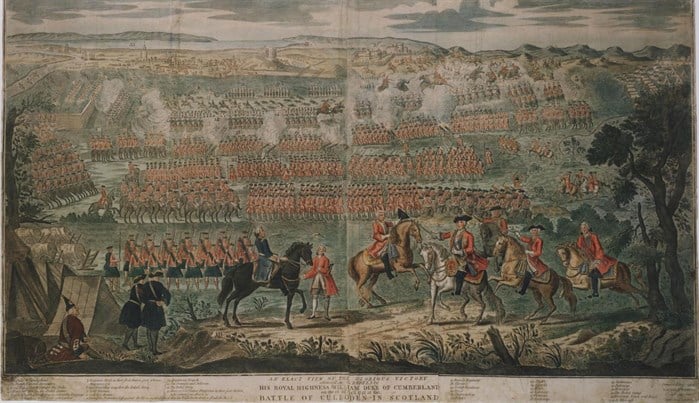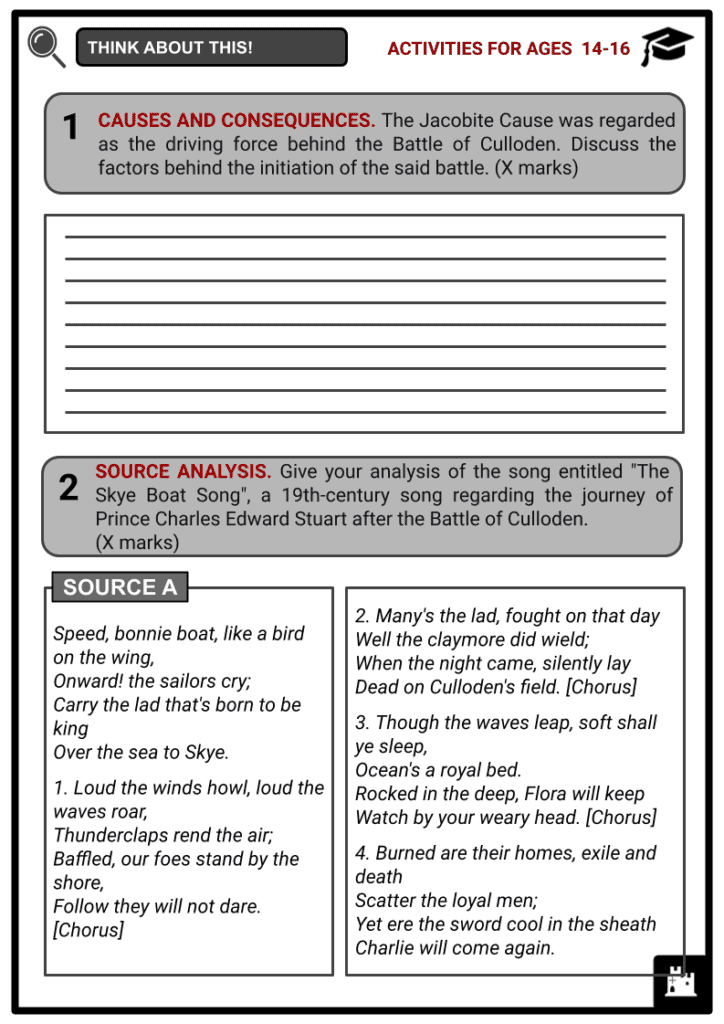Battle of Culloden Worksheets
Do you want to save dozens of hours in time? Get your evenings and weekends back? Be able to teach about the Battle of Culloden to your students?
Our worksheet bundle includes a fact file and printable worksheets and student activities. Perfect for both the classroom and homeschooling!
Summary
- Bonnie Prince Charlie’s Campaign
- The Battle
- Aftermath and Significance
Key Facts And Information
Let’s find out more about the Battle of Culloden!

The Jacobite Rising of 1745, an effort by Charles Edward Stuart, popularly known as Bonnie Prince Charlie, to re-establish the Stuart line on the British throne, ended in the Battle of Culloden.
On 16 April 1746, combat took place in Scotland, near Inverness. The British army, led by the Duke of Cumberland, son of King George II, defeated the Jacobite forces, mostly Scottish Highlanders. Over 1,500 Jacobite soldiers and 50 government soldiers died in the bloody battle. Following this, the British government suppressed the Scottish clan system and banned the Highland culture, such as the use of tartan and bagpipes.
The Battle of Culloden is remembered in literature and music, especially the well-known Scottish ballad 'Bonnie Charlie,' and is regarded as an essential event in Scottish history.
Bonnie Prince Charlie’s Campaign
- The Jacobite Cause was regarded as the driving force behind the Battle of Culloden. The exiled Stuart dynasty was attempting to reclaim the British throne. In 1688, the Stuarts were deposed and replaced by the Protestant Hanoverian dynasty, which most British people supported.
Who were the Jacobites?
- The Jacobites first appeared in the 17th century, following the expulsion of the Stuart Dynasty, Great Britain's Catholic rulers.
- After King James II, a Catholic was deposed in the Glorious Revolution of 1688 by his Protestant daughter Mary II and her husband William III, the Jacobites appeared to support the Catholic king. Many Jacobites saw James II's son, James Francis Edward Stuart, as the rightful heir to the throne, and they supported his claim to the British throne even after the Hanoverian dynasty took power in 1714. Their name was derived from the Latinised version of the word 'Jacobus.'
- Charles Edward Stuart, also known as Bonnie Prince Charlie, began a campaign to reclaim the throne in 1745. He was the leader of the Jacobite forces and a claimant to the British throne at the time. He arrived in Scotland with a small party of men and quickly gained the support of Scottish clans dissatisfied with the British government.
- The Highland clans had traditionally supported the Jacobite cause, seeing it as a way to reclaim their autonomy and challenge the British government's attempts to suppress their culture and way of life.
- In response to the campaign, the British government raised an army commanded by the Duke of Cumberland, William Augustus, who was also known as the 'Butcher Cumberland'. Aside from the duke's brutal tactics against the Jacobite rebels, the government forces were well-trained and well-equipped with superior weaponry.
- The Jacobite army relied heavily on the charge and used traditional Highland tactics based on close combat. On the other hand, the government forces used artillery and musket fire to devastating effect against the Highlanders.
- The Jacobites had won a decisive victory in the Battle of Falkirk before the Battle of Culloden, giving them confidence that they could win the war. This victory, however, was short-lived because the government forces regrouped and prepared for a fight at Culloden.
The Battle
- The Battle of Culloden took place on 16 April 1746 and was considered the final confrontation of the Jacobite Rising.
- Bonnie Prince Charlie led the Jacobite army south into England to reclaim the throne of Great Britain for the exiled House of Stuart. The Jacobites had garnered enormous backing from the Scottish Highland clans, but the government soldiers outnumbered them.

Depiction of soldiers (private and corporal) of the Highland regiment, circa 1744. - The Jacobites arrived at Culloden Moor, near Inverness in the Scottish Highlands, on 15 April 1746. The government soldiers, headed by the Duke of Cumberland, had been following the Jacobites for weeks before finally apprehending them on the morning of April 16th. The government forces outnumbered and outgunned the Jacobites despite them having chosen a solid defensive position on the moorland.
- The government had a large stock of cannons compared to the limited weapons the Jacobites had. Around 1:00 PM, government artillery began firing on Jacobite positions, sparking the conflict. As the Jacobites retaliated, they were met with a hail of musket and cannon fire. The Jacobites tried to reorganise but were greeted with another deadly bombardment of musket and cannon fire.
- Soldiers from the government pursued the disheartened Jacobites after their failed charge. When the Jacobites attempted to organise themselves, they were met with another musket and cannon fire barrage. Less than an hour was spent in the fight. While the British government soldiers suffered only about 50 fatalities, the Jacobites suffered significant losses, with 1,500 dead or injured.
- The House of Stuart's attempt to recover the British crown ended with the Jacobites' defeat. It had significant effects on the Scottish Highlands. Following the battle, the British Government forces tracked down Jacobite rebels for months, executing a number of them and imprisoning others. Repression of the Highland way of life and the evacuation of numerous communities were also prevalent.
Aftermath and Significance
- For Scotland and Great Britain, the consequences of the Battle of Culloden were significant and far-reaching. A pivotal event in British history, the defeat of the Jacobites at Culloden established the Hanoverian dynasty's grasp on the British throne. It paved the way for a time of comparatively stable politics in the United Kingdom.
- The attempt of the House of Stuart to reclaim the British throne was vanquished when they were defeated at Culloden. Several Jacobite rebels were executed or imprisoned in the years that followed the battle, and the movement's cause was generally suppressed.

The Culloden Battlefield Memorial Cairn - In addition, the aftermath of the fight had a significant impact on the Scottish Highlands, as many Highland communities were forcibly evacuated from their homes as part of the clearances. The British government put a set of policies to eradicate Highland culture and way of life.
- The British government imposed the Act of Proscription in the years following the conflict, making it illegal to wear traditional Highland dress, carry weapons, or speak Gaelic. This law was in effect until 1782.
- The Battle of Culloden is a significant part of Scottish culture, heavily influencing their history and society. It can be found in their literature, art, and music. Furthermore, the combat is extensively researched for its military strategies and tactics because it was one of the last significant conflicts to be fought in the traditional Highland manner, with clan members using swords and shields to attack.
- The Battle of Culloden was an essential event with far-reaching effects for Scotland and the United Kingdom. It symbolises a pivotal point in the conflict between the Jacobites and the Hanoverians and is still remembered and honoured today.






